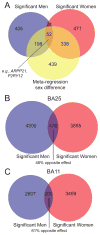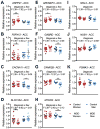Opposite Molecular Signatures of Depression in Men and Women
- PMID: 29548746
- PMCID: PMC6014892
- DOI: 10.1016/j.biopsych.2018.01.017
Opposite Molecular Signatures of Depression in Men and Women
Abstract
Background: Major depressive disorder (MDD) affects women approximately twice as often as men. Women are three times as likely to have atypical depression, with hypersomnia and weight gain. This suggests that the molecular mechanisms of MDD may differ by sex.
Methods: To test this hypothesis, we performed a large-scale gene expression meta-analysis across three corticolimbic brain regions: the dorsolateral prefrontal cortex, subgenual anterior cingulate cortex, and basolateral amygdala (26 men, 24 women with MDD and sex-matched control subjects). Results were further analyzed using a threshold-free approach, Gene Ontology, and cell type-specific analyses. A separate dataset was used for independent validation (13 MDD subjects/sex and 22 control subjects [13 men, 9 women]).
Results: Of the 706 genes differentially expressed in men with MDD and 882 genes differentially expressed in women with MDD, only 21 were changed in the same direction in both sexes. Notably, 52 genes displayed expression changes in opposite directions between men and women with MDD. Similar results were obtained using a threshold-free approach, in which the overall transcriptional profile of MDD was opposite in men and women. Gene Ontology indicated that men with MDD had decreases in synapse-related genes, whereas women with MDD exhibited transcriptional increases in this pathway. Cell type-specific analysis indicated that men with MDD exhibited increases in oligodendrocyte- and microglia-related genes, while women with MDD had decreases in markers of these cell types.
Conclusions: The brain transcriptional profile of MDD differs greatly by sex, with multiple transcriptional changes in opposite directions between men and women with MDD.
Keywords: Corticolimbic; Depression; Genetics; Meta-analysis; Mood disorders; Sex difference.
Copyright © 2018 Society of Biological Psychiatry. Published by Elsevier Inc. All rights reserved.
Figures




Comment in
-
Sex-Specific Molecular Changes in Depression.Biol Psychiatry. 2018 Jul 1;84(1):2-4. doi: 10.1016/j.biopsych.2018.05.005. Biol Psychiatry. 2018. PMID: 29929577 No abstract available.
References
-
- WHO. The global burden of disease, 2004 update. 2008:1–146.
-
- Perugi G, Musetti L, Simonini E, Piagentini F, Cassano GB, Akiskal HS. Gender-mediated clinical features of depressive illness. The importance of temperamental differences. Br J Psychiatry. 1990;157:835–841. - PubMed
-
- Kornstein SG, Schatzberg AF, Thase ME, Yonkers KA, McCullough JP, Keitner GI, et al. Gender differences in chronic major and double depression. J Affect Disord. 2000;60:1–11. - PubMed
-
- Kessler RC, McGonagle KA, Nelson CB, Hughes M, Swartz M, Blazer DG. Sex and depression in the National Comorbidity Survey. II: Cohort effects. J Affect Disord. 1994;30:15–26. - PubMed
-
- Kessler RC, McGonagle KA, Zhao S, Nelson CB, Hughes M, Eshleman S, et al. Lifetime and 12-month prevalence of DSM-III-R psychiatric disorders in the United States. Results from the National Comorbidity Survey. Arch Gen Psychiatry. 1994;51:8–19. - PubMed
Publication types
MeSH terms
Grants and funding
LinkOut - more resources
Full Text Sources
Other Literature Sources

